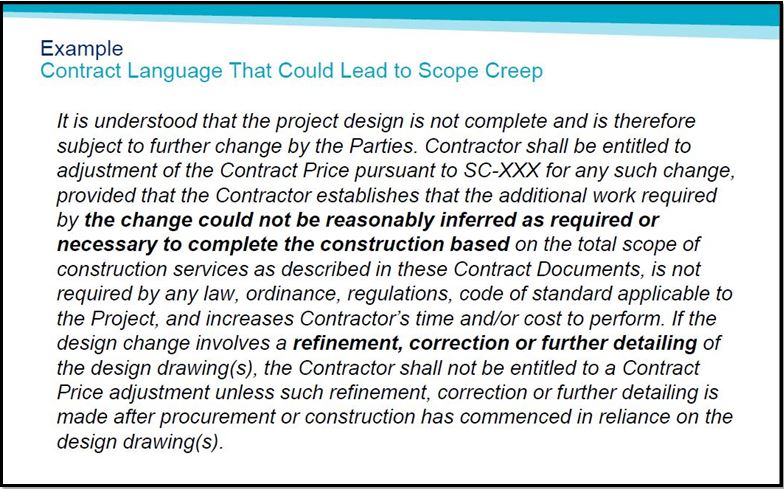By Steve Rizer
One of the keys for avoiding “scope creep” in a construction project is to ensure clear contract language, Todd Vandenhaak, senior vice president at Marsh Risk Consulting, told professionals attending “Avoiding the Pitfalls of Scope Creep in Construction Projects,” a WPL Publishing webinar for which a recording recently was added to the ConstructionPro Network (ConstructionProNet.com) Download Library -- free of charge for members. He and fellow Marsh Managing Consultant John Ciccarelli offered plenty of advice on this topic to a target audience of engineers, architects, risk management professionals, construction and project managers, presidents, vice presidents, contractors, subcontractors, and others.
Terms such as “to builder’s selection,” “typical,” and “reasonably” can make for ambiguous contract language and give rise to scope creep, which involves uncontrolled changes or continuous growth in a construction project’s scope. “And this isn’t to say that if you see these words in your contract, you’re going to have scope creep or a lack of clarity,” Vandenhaak said. “They are, I’ll say, words to flag that you need to put a little more attention into how [they are] being used.”
From the files of projects that his firm has participated in, Vandenhaak provided to webinar attendees the following example of unclear contract language that could engender scope creep, with particularly damaging language in bold:

“If you’re looking at what a contractor might be entitled to for a change, they’re saying here the change could not be reasonably inferred, as required, for whatever that means, but that was in the contract that was signed,” Vandenhaak said.
“Going down to the bottom of this paragraph [in the figure], we see a little later that if the design change involved a refinement, correction, or further detailing, the contractor is not entitled to a price adjustment,” Vandenhaak pointed out. “So, … it just wasn’t really clear or, in this case, the owner was transferring a lot of risk or allocating a lot of risk to the contractor, and that’s something that needs a little bit of, I’ll say, a heightened awareness by the contractor in negotiating these terms and conditions because, as a result of this one, which was a transportation project, it ended in a pretty significant dispute. And a lot of the questions were around that very specific language [stating,] ‘reasonably inferred.’ What does that [term] mean? What should we have reasonably inferred? And so, that started out as a root cause for scope creep and, like I said, it ended up being a pretty significant claim. [It is] not atypical to see that type of contract language.”
Other causes of scope creep can involve unclear deliverables and performance requirements, a scope of work that is not defined well, incomplete design documents, and a failure to involve stakeholders and end users, Vandenhaak said.
Also during the 90-minute webinar, Vandenhaak and Ciccarelli discussed what scope creep is, how scope creep can impact a project, methods of minimizing or avoiding scope creep, change order management, and other subjects involving scope creep.
For immediate access to the complete webinar (full audio and visual) -- as well as more than two dozen other construction-related webinars that are available for download -- sign up to become a member of WPL Publishing’s ConstructionPro Network, a complete training, education, and development resource for the construction industry, at http://constructionpronet.com/info/Charter2012.aspx.

